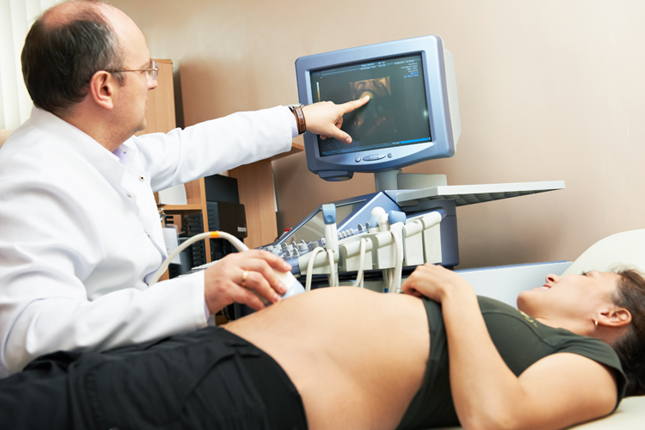Preggie Pals
Ultrasounds During Pregnancy: What to Expect
[00:00:00]
Please be advised, this transcription was performed from a company independent of New Mommy Media, LLC. As such, translation was required which may alter the accuracy of the transcription
[Theme Music]
MISHELLA PEREZ: An ultrasound is your first opportunity to meet your baby face to face. It can also provide important information about your child’s growth and development. But are ultrasounds really safe? And what typically happens during the procedure. I’m Mishella Perez, a Perinatal Sonographer and owner of First Hello, a company providing mobile 3D and 4D ultrasounds services to expecting mothers and their loved ones and this is Preggie Pals, episode 87
[Theme Music/Intro]
SUNNY GAULT: Welcome to Preggie Pals broadcasting from the Birth Education Center of San Diego. Preggie Pals is your weekly online, on-the-go support group for expecting parents and those hoping to become pregnant. I’m your host Sunny Gault, would you like bonus content after each shows, great giveaways and discounts? Then join our Preggie Pals Club and you can visit our website at www.preggiepals.com for more information. Another way for you to stay connected is by downloading our free Preggie pals app, it’s available in the Android and iTunes market place and by subscribing to our monthly newsletter.
If you do not live in San Diego but you would like to be a panelist on our show, you can still participate thru our virtual panelist program. You can follow us on facebook and twitter for a sneak peak of the questions we’ll be exploring during our shows and if you are on twitter, use hash tag #preggiepalsvp, which stands for virtual panelist and submit your comments for a chance to be on our show and you can also ask our experts questions that way so you can participate in all of our conversations. We will also select one lucky winner to win a free membership to the Preggie Pals club.
So before we get started with our show, let’s meet some of the people here in the studio who is going to be having this lovely conversation with us, and let’s start with Annie
ANNIE LAIRD: Hi! My name is Annie, and I’m going to be starting in 2014 taking over hosting duties from Sunny for Preggie Pals. So, I’m very happy that I could be here today. I’m here with my newborn, Stella, and she is five days old. So if you hear little baby coo’s, that’s what that is. I’m 35 years old. During the day, I may a contracted military instructor, and I have two other children, a sixteen month old named Lucy and the eight year old named Clara.
SUNNY GAULT: Okay. You guys know me but I’ll kind of do a brief introduction here. My name is Sunny, I’m the host of the show, I also own new mommy media which produces not only Preggie Pals but Parents Savers, The Boob Group and our new show Twin Talks. And the reason we are launching twin talks is because I am pregnant with identical twin girls and I have two little boys at home. My boys are 3 years old and eighteen months. So the girls kind of even the score. We got, two and the two on the way, and then we’re done. Which is one of the reasons why I need to hand this over to Annie, I can’t get pregnant again. And then, okay, so let’s meet Mishella here in the studio. Mishella is our expert for today’s episode; tell us a little bit about yourself.
MISHELLA PEREZ: My name is Mishella Perez, I’m currently a fetal sonographer at UC San Diego Medical Center and I also have my business, First Hello
SUNNY GAULT: Absolutely, and you’re a mom too.
MISHELLA PEREZ: And I’m a mom too, definitely. I have a twelve year old son, very big, twelve year old, still my baby and I do plan to have baby soon again.
SUNNY GAULT: Yeah and you recently got married.
MISHELLA PEREZ: And I recently got married.
SUNNY GAULT: Yes! You’re still a newlywed.
MISHELLA PEREZ: Up soon.
[Theme Music]
SUNNY GAULT: Alright before we get started with today’s show, we are going to review a pregnancy app and we like to do this for all of our listeners. I know a lot of you guys listen to Preggie Pals on our Preggie Pals app so you guys are very app friendly and specially if this is your first time pregnancy. I know there are a lot of things you want to track and remember about your pregnancies and so we want to help you out with that.
The app we are reviewing today is called Baby Bump Pregnancy app. I know it’s available on the iPhone, I believe it’s on android as well. There is a free version and a paid for version. I did not upgrade to the paid version, so you guys are going to get too short and sweet today of what the free version offers. But it is nice being a soon to be mom of twins. It does allow you to enter more than one baby if you’re pregnant with twins or multiples. So, that kind of appealed to me a little bit. It does have a lot of stuff that some of the other apps have. I think they’re kind of gearing themselves to be a one stop shop. So, you know, when you first log in, you know immediately you can see what the baby’s size is supposed to be right now. If you’re pregnant and then it gives me a fruit comparison, it’s a cantaloupe I guess now is what one of my babies is compared
ANNIE LAIRD: I like the fruit comparison. I work in an environment with guys and they don’t get like weeks and any of that
SUNNY GAULT: But if you said it’s as big as a cantaloupe
ANNIE LAIRD: But if you said the baby is as big as a pineapple, that, they understand
SUNNY GAULT: It gives you the baby’s weight approximately and kind of like image of kind of what the baby looks like, those always crack me up. Also, you know what your belly kind of might look like which I don’t know, that varies a lot. That’s kind of dangerous territory. But it does talk about, what’s going on within your body and all this is kind of on the main screen and then you can kind of scroll around. There’s a section you can add your own photos. They do have a form section which I thought was helpful and if you want to upgrade you can upgrade and do like the kick counter and what’s the other big one? Oh! The contraction timer. And you know, Mishella we were talking before the show started and you said “They didn’t have all these apps when I was pregnant”
MISHELLA PEREZ: I know, they never did, I am just so surprised to see everything on, you know app form on the iPhone
SUNNY GAULT: Do you think you would use something like this?
MISHELLA PEREZ: I would. I think it will be helpful for me. I mean all of us now mothers I can see all have iPhones. It’s such a very useful tool. And having an app there is just, it’s very helpful
ANNIE LAIRD: It’s nice too, it opens right up, as Sunny I was looking in your phone too, how many weeks you are, which when you know, with my first I knew down to like the minute and the second. Well I can see, 34 weeks ago, and they really want to know that type of detailed information. But, as you have more children, I would forget all the time what week I was and people would ask me and I look like an idiot, you know I, “Oh I’m pregnant, gosh how did that happen?”. But you can open up your iPhone and say “Oh”, immediately, “Oh, I’m 34 weeks, in my 34th week today” if the guys said I was working with. The women know. The women that I hang out with, they understand weeks.
SUNNY GAULT: Like I said this does have ads in it so I don’t know if you guys are fans of add. If you guys, you know would right and sure would upgrade, they call it Baby Bump Pro, then the ads go away. But it looks like there’s some ads in here. So I think overall I give this a thumbs up. What do you guys think?
MISHELLA PEREZ: Thumbs up
SUNNY GAULT: Yeah, recommend it to another parent
ANNIE LAIRD: Thumbs up
SUNNY GAULT: Yeah. Okay great
[Theme Music]
SUNNY GAULT: For most pregnant women, ultrasounds are common part of your prenatal care. But you can also choose to have elective ultrasounds to determine baby gender or just share a special moment with friends and family. Joining us in this studio today is Mishella Perez, a Perinatal Sonographer who has her own mobile ultrasound business and I’ve personally experience this business. Mishella has come over to my house and done ultrasounds and personally for me and my family and I can tell you guys a little bit more about that later. But, Mishella, let’s first start the conversation by talking about ultrasounds. Welcome to our show, it’s a pleasure to have you here.
MISHELLA PEREZ: Thank you. I’m happy to be here
SUNNY GAULT: Okay. So we’re talking about the basics of ultrasounds here. Let’s just talk about definition, what exactly is an ultrasound?
MISHELLA PEREZ: Well, ultrasound basically when you’re talking about physics and physics would actually be high frequency sound that the human ear cannot catch
SUNNY GAULT: So sound waves?
MISHELLA PEREZ: Sound waves basically. But, when it comes to ultrasound, as a medical ultrasound, a method that utilizes high frequency sound waves that bounces off tissues and that’s what creates the images
SUNNY GAULT: Okay. So we’re working with sound waves to form some sort of an image that we can see and that’s the same whether it’s a 2D, 3D, whatever, same thing, same type of technology. And is there a difference because I always get confused with this, between having an ultrasound and a sonogram, like when we introduced you as a Sonographer, so, I hear these terms used and I don’t know if there’s really a difference between the two
MISHELLA PEREZ: Well for ultrasound, ultrasound of course is the method , it’s the procedure itself and sonogram is the image produced by the ultrasound.
SUNNY GAULT: I see, okay
MISHELLA PEREZ: Basically, and a sonographer is a person who does the ultrasound.
SUNNY GAULT: Okay. Okay. Okay. That makes a lot of sense. So, the big question a lot of people have are, are ultrasounds safe? You know, there is a lot of women that don’t want to have ultrasounds or at least wants to limit them. You know I’ve talked to a lot of women that they’re a little bit, you know, scared of them
MISHELLA PEREZ: With ultrasounds as of say there has not been, you know, no known biological effects. I mean it’s been used for many-many decades and a lot of the machines that were used like you know the famous machines like General Electric, Philips, Siemens, all of those are calibrated, operated to the safe operating standards. So, a lot of, I guess, how would you say this, a lot of people who research in ultrasound get what they get on the internet. And I think you pull up all these studies, then a lot of these studies that I’ve read too, they’re actually based on ultrasounds that exceed those intensities that the ultrasound machines don’t use at all. It’s far, you know, way higher output intensities and on top of that they do these experiments for hours at a time.
SUNNY GAULT: Which you never having an ultrasound for hours at a time
MISHELLA PEREZ: No. Not at all! Ultrasounds are pretty much limited to an hour for diagnostic. Not unless clinically indicated they would want to evaluate something else or have you come back for elective ultrasound is definitely kept less than 30 minutes for sure
SUNNY GAULT: Okay. Annie what are your thoughts on ultrasounds?
ANNIE LAIRD: I think that you can read a lot of things in the internet and gets scared of it, you know and, I’m involved in the birth community and there’s definitely, different thoughts of safety and libeling things. I think everyone just has to find a medical care provider that they trust and go on what could research indicates. I mean for me personally, there wasn’t a medical reason to have an ultrasound but everybody’s in a different situation, I mean, I had a couple of miscarriages and so, for me, an early ultrasound just to get a heartbeat checked, I need that for my mental health more than I needed it for physical health.
It’s really same thing with the baby that I’m holding right now, whose sleeping so wonderfully. Keep sleeping baby. I had one at twenty eight weeks not because I want to know the gender but just because for my piece of mind I want to know going in are there markers for down syndrome, not that anything would be you know, done you know again that’s a very personal decision, but I want to know going in to, you know, do I have to prepare and have things ready when it’s time for the birth, is my baby being born with special circumstances or you know, a special situation with some medical needs that could be indicated by an ultrasound, you know and so when the bill of health came up clear, again for my own mental health, I felt it was worth getting that ultrasound even though you know technically, yes, would I have a very healthy baby without the ultrasound? Sure. So, it’s more for me than for my baby
SUNNY GAULT: So, Mishella, how accurate would you say ultrasounds are and does it depend on the equipment because I know not all ultrasound equipment is created equally
MISHELLA PEREZ: Well, let’s see, I’ve worked with various machines . I believe accuracy is dependent on many factors, you know such as gestational age, also based on fetal positioning, is also based on operator’s experience, so, sonographer’s experience and also you know like what you mention depends on what type of machine you would use. The accuracy of ultrasound is greater in the first trimester when determining due date
SUNNY GAULT: So, if there’s any ultrasound that’s super important it’s probably about first one is that what you would say?
MISHELLA PEREZ: Yes. The accuracy is higher in terms of the due date. And also ultrasounds have a higher accuracy in predicting gender after sixteen weeks but even as early as fourteen weeks, but then again you have all these factors
SUNNY GAULT: Right, exactly. So, I have a question. So, the ultrasound machine, now I see a perinatologist, but before we knew that they were twins, I was seeing a regular OB, and there’s different machines that are in the OB’s office than what my perinatologist uses, So, what can we tell people as far as, we mention there’s different types of brands of machines right we went to that but, what do we need to know about something that again we would use in an everyday OB environment versus your 20 week ultrasound or something like that, you know, I mean, do they, are they, the machines drastically different and how are they different?
MISHELLA PEREZ: You know there are many models of ultrasound machines out there such as General Electric (GE), Philips and the Siemens which are few of the popular ones that are utilized in OBGYN clinics and hospitals. All the machines are good and you know they share all the same level of accuracy to evaluate a pregnancy but others may have better features and upgrades.
SUNNY GAULT: Like what are some of the, upgrades and features?
MISHELLA PEREZ: I would say like for example a lot of the high risks clinics have a program where you could, a package where you could specify just to view the fetal parts. Now there’s a setting for that, that you know, like people would set up specific settings just for the fetal hearts.
SUNNY GAULT: So for brand new mama’s or mama’s to be out there who have never had an ultrasound before who are listening to this, what can we expect during an ultrasound, what typically happens?
MISHELLA PEREZ: First, you know, when I see a patient working at the U, I do introduce myself and bring them to exam room. I also try to explain to them the type of ultrasound they’re having, whether be a growth or anatomy scan, tell them how long it is, what to expect and then I also verify their due date, most importantly. I have them sit on the scanning bed to get them have them laid down very comfortable and you know prop their pillows, one pillow underneath their knees and then that’s when I put the gel on them
SUNNY GAULT: Why is it important that we are in that kind of reclining position?
MISHELLA PEREZ: In late trimester, you want to be slightly elevated up, so, you won’t lay flat on your back so you won’t be compressing your great vessels. What happens is like with, I know since you’re pregnant with twins, you would have to lay on your side due to the pressure of babies laying on your back you tend to constrict the blood flow going up to your head therefore it makes you nauseated, dizzy?
SUNNY GAULT: So it’s really for our comfort
MISHELLA PEREZ: Yes, basically
ANNIE LAIRD: What is the purpose of the gel?
MISHELLA PEREZ: So the gel, ultrasound cannot travel through air so the gels serves like as a medium. So when you have the gel, with the ultrasound transducer which is admitting the sound waves, it helps transmit the sound waves to the skin. So that’s the reason for it.
ANNIE LAIRD: Does the temperature of the gel has anything to do with that? Well it’s interesting, because the last ultrasound I had it was very warm but the ultrasound place where I got my ultrasound it’s not like they just do ultrasounds for babies like they did ultrasounds for prostates. I’m like it was the first time that I had warm gel
MISHELLA PEREZ: We utilize, at the U we do utilize you know bottle warmers and it’s amazing because moms would brace literally as in like, here’s gel and like their face would be squinting and then like “Oh! It’s warm”, oh yes it’s warm. So, yes, I mean most places I know they would provide the warm gel, I mean I could imagine, doing other ultrasounds other than babies and then be so cold
SUNNY GAULT: Okay, so now we kind of know what to expect in an ultrasound right? So, we need to clarify this a little bit, so for low risk pregnancies, because I’m considered high risk, I get a lot more ultrasound. But we’re talking about the average pregnancy, how many ultrasounds will a pregnant woman get?
MISHELLA PEREZ: For low risk, based on what I, the clinic that I worked in, we get about three, for low risk. So, three means to say that the very first one is the first trimester ultrasound verifying dates, verifying, everything’s fine you do a few prenatal testing’s along with that. Then you have, then you come in for second trimester ultrasound which is the anatomy scan which is between 18 and 20 weeks, if that clears out well, you know everything’s good, then you don’t come back anywhere between, I’d say 32 to 38 weeks for your growth and that is usually is the final growth scan.
SUNNY GAULT: I think, and Annie I don’t know if you can chime in on this because I know you’ve received a different prenatal than me, but it seems like with my singletons, I really only had, well it’s a little bit different with my last because I had gestational diabetes so they’re doing a lot of non stress test
ANNIE LAIRD: But my first two I had the OB care for my first and then my second I had Co- care, and maybe a little bit different too because I had military insurance and they’re cheap. So, you know, it was like, do we have to pay for this? No. So, I mean, for my first one, I only got one, I got the anatomy scan which is for we found out the baby’s gender. For the second one I had had three losses in between my first and my second babies. And so, that was me begging and pleading and saying “I’m going to be a basket case, unless I can, you know, I can’t wait for the doppler, like I need to see this and so that was the only reason that I got a second ultrasound
MISHELLA PEREZ: It depends, we usually get referrals for the anatomy scan too, but, you know, it’s the Co-Care like they had a midwife and once we clear out with the anatomy scan they continue their care with the midwives. So it varies and also depends on the insurance, depends on your doctors, what they want, if sometimes they want patients to come to us just for the first trimester to make sure everything that’s fine then they continue the anatomy. But generally, that’s usually three. That’s all
SUNNY GAULT: Okay. When we come back, we’ll discuss the different types of ultrasounds common during pregnancy, also, what is the difference between a 2D, 3D and 4D ultrasound. We’ll be right back.
[Theme Music]
SUNNY GAULT: Welcome back, today we’re discussing ultrasounds and what to expect during your prenatal care. Okay so, Mishella, when we’re talking about different ultrasounds, we hear stuff about like, okay this is a level one ultrasound, this is a level two, can you kind of break that down for us and tell us what exactly are we talking about there?
MISHELLA PEREZ: So, level one ultrasound is the basic, pretty much. Mainly of course people usually go thru level one initially if you’re low risk. The sonographer just takes measurements and images of your developing baby and they also assess the surrounding structure such as your ovaries, uterus, babies, placenta and amniotic fluid. If suspected for abnormalities or anything that they seen in ultrasound, then that’s when you get moved on to level two. For level two, ultrasounds are more in depth, we do everything that level one does but focus more on specific areas such as the heart, the brain, the spine, the limbs you know, all of structures
SUNNY GAULT: So like you’re 20 week, is that a level two?
MISHELLA PEREZ: Level two, you could actually go in this first trimester in level two as well, So, when you say level two it’s the type of specialty that’s provided like the type of doctors that are also there. So for level two you could have a prenatologist, and you could have a radiologist who is a fetal specialist
SUNNY GAULT: So meaning all of my ultrasounds now are with the prenatologist, does that mean all of mine are considered level two because it’s a prenatologist it’s doing it.
MISHELLA PEREZ: Yes.
SUNNY GAULT: Okay, it’s not just about the type of equipment they are using it’s about who‘s there, who were their pay grade is.
MISHELLA PEREZ: And with level two the sonographers are also trained to look at specific things. To look at the heart, to look at the brain, to look at other aspects. So it’s very in depth with sonography, it’s a specialized field.
SUNNY GAULT: So we hear a lot about 2D, 3D and 4D ultrasounds. Okay, so, let’s break this down a little bit because I think there’s a lot of confusion as to what does what? So, help us break this down Mishella.
MISHELLA PEREZ: So, 2D ultrasound is the traditional method that everyone sees, it’s a basically black and white, flat, two dimensional screening of babies. So for in example when the first thing that mom noticed is this is a profile of you and your ultrasound, that’s 2D. With 3D ultrasound, it’s an advanced method of 2D, this is where you’re able to capture baby’s face, just the face.
SUNNY GAULT: So, we’re not talking about the body?
MISHELLA PEREZ: No. Pretty much anything. So three dimensional is just
ANNIE LAIRD: The third aspect of dimension. It looks like it’s coming out the screen and you’re like “Oh, I could recognize that face” and this is where we’re like “Well that blur is like the nose might be like the husbands or
SUNNY GAULT: Or it’s a shadow
ANNIE LAIRD: Exactly. Oh wait, no that’s the elbow
MISHELLA PEREZ: So basically it’s just, you know, it’s a software acquisition of 2D. And that’s where you could appreciate, like what you said, baby’s face. You know you could notice certain features like “Oh, baby has mom’s nose or dad’s lips”. With 4D ultrasound is actual 3D ultrasound but moving in real time. So you get to see baby yawn, you get to see baby move, you get to see baby make facial expressions in ultrasound but it’s three dimensionally. Three dimensionally but 4D is 3D in real time.
SUNNY GAULT: So, if you took a video of 3D will that be 4D then?
MISHELLA PEREZ: That’s correct
SUNNY GAULT: I see. So it’s moving images of the 3D. Okay. So but if I just had a still image it would be 3D
MISHELLA PEREZ: Still image, three dimensionally, 3D
SUNNY GAULT: Yes. Okay so that’s the difference then. Got it. And are there different machines that do, I mean are there just machines out there that just do 2D? As opposed to the 3D, 4D?
MISHELLA PEREZ: Yes there is, there are certain machines that don’t have the 3D, 4D capability, it depends what specialty you’re in but most, majority of most clinics would have them.
SUNNY GAULT: Okay. Would there be a reason like when I hear you know people talk about 3D, 4D it’s usually, “Oh I want to see what my baby looks like or perhaps baby gender or something like that”, but, would there be a medical reason why you would want to see a 3D,4D image?
MISHELLA PEREZ: Actually we do 3D as part of our, for diagnostic purposes we utilize 3D to, you know, investigate certain spine abnormalities. We also use it to evaluate certain facial abnormalities too as well as cleft lip palate. We also utilize it to take a look at the brain. So, with 3D, when this is three dimensionally, not only is it superficially but we could render it in three slices. It’s probably what you guys don’t see in three dimensional but we’re able to see it as we’re trying to look so we’re able to see baby structure in three planes. So when you want to look at a brain abnormality or you want to make sure that baby doesn’t have for example like a Chiari malformation as where the cerebellum is like a banana shape we do 3D rendering of that to make sure that you know, is the actual cleft present or not. So, it’s used widely in a lot of clinics who use it for that purpose.
ANNIE LAIRD: I had a question about 2D versus 3D. Some of the tin foil hat websites talk about well there’s more power with the 3D. Is that true? Or is there more risk with the 3D, 4D or you know because I think the assumption is oh well you’re just getting a 3D because you just want to see your baby’s face. I mean it sounds like what you’re saying is that there’s real good medical reasons that 3D could come in real handy and it’s a great tool for the medical care provider
MISHELLA PEREZ: So with the difference between 2D, 3D is there any like extra exposure, there is absolutely none. Like all of this is with the 3D, 4D is just data acquisition, so it’s actually the computer technology that’s in the ultrasound machine that renders that. Which is amazing, I think, it does not
ANNIE LAIRD: It’s not like your transmitting more power into the belly
MISHELLA PEREZ: Not at all. It’s the same exposure as 2D. And I’m glad that you mention, that’s a really great question because a lot of people always ask and I told them it’s just the same output as you have with the 2D all it is, is just computer manipulation, no increase intensities no zapping way of you know sound waves actual sound waves at all. It’s completely the same as 2D
SUNNY GAULT: So up until this point we’ve really been talking about the ultrasounds that you would get by your OB more for medical reasons but I want to shift the focus a little bit because there’s another side of this, the elective ultrasound, so we can receive, and a lot of this, I certainly find no fault in this, I’ve done this with all of my kids. I do want to know whose nose that baby has before I see them come out of the birth canal.
ANNIE LAIRD: For my personal situation it was really neat where I don’t have family nearby so to have, it was just a DVD taken looking at the screen basically as a sonographer was doing his images but that was sure nice you know dad was on deployment nine thousand miles away and so for him, I could mail him the DVD and then it was like he could be involved in the pregnancy. So, that’s just a really neat surface
SUNNY GAULT: Mishella, what are some of the common reasons that people have elective ultrasounds?
MISHELLA PEREZ: Well first off elective ultrasounds are very optional. So it’s up to mom if she would want one. We primarily just focus on just superficial structures so we look at the face, we look at the foot, we look at the fingers we look at the back of baby’s spine. Sometimes we have parents listen to baby’s heartbeat and also just watching baby in 4D. So I think the reason why mother’s choose to have elective ultrasound is that, it’s simple, it’s they want to see baby. Elective ultrasound I think is the extra time that you don’t get when you do a prenatal ultrasound.
Because when you do a prenatal ultrasound, you know the sonographers are basically just looking out after one thing and that’s the baby’s well being. You don’t have time to really show all the little details that you’d want to show your husband or your kids and with elective ultrasound, it provides that little bonding time of reassurance like how you wanted to hear baby’s heartbeat it was just that one thing that will make you happy and content inside. That’s what I think
SUNNY GAULT: Okay, well Mishella, I definitely want to talk about your business because I feel like you’ve taken this to the next level and it’s something that I’m really excited about, as you guys know I’m a mom of two already with two on the way and as we were just saying it’s hard to you know the whole thing about not being able to videotape or take your kids in to where you’re having your ultrasound performed. It always kind of rung me the wrong way because I always felt like it was supposed to be a personal experience and a memorable one and I love what you’ve done so tell us a little bit more about First Hello.
MISHELLA PEREZ: I’ll just let you know how it all first started. With First Hello, I’ve been working in a fast paced field for over six years now. I’ve seen the experiences that mothers would go through, good and bad. I think that there should be more time for bonding. I think, mom, it should all be about mom, you know, give her the extra time to want to look at baby’s face, baby’s foot, baby’s hand anything. To even share that experience with her kids, her kids running around the house, the kids being there, her friends, grandparents. So with First Hello that’s how it was born
SUNNY GAULT: Yeah. So we need to clarify. It’s a mobile company right? So you go to people’s homes. And then that’s the difference between goggling 3D, 4D ultrasound companies as most of those have their own places where you’re still going to have to travel. And then there’s great things about those too, I don’t want to knock those but what I really love is that again, the more kids you have the less mobile you become as a mom right? So I was very grateful when Mishella came over to my house to do this personally. And I should say that Mishella’s the first person that told me that they were girls. Which was an amazing experience in itself? I love that you launch this business. I know there are not a lot of companies out there that are doing this. In fact I think you said there’s like a handful across the nation right?
MISHELLA PEREZ: Yes. There’s only I would say a handful in the United States that are doing it and I think I’m the first in San Diego
SUNNY GAULT: Yes. Well congratulations to you. I think this is amazing. A lot of kudos for starting your own company. Well thanks Mishella for joining us today
MISHELLA PEREZ: You’re welcome
SUNNY GAULT: For more information about Mishella as well as our panelist, you can visit the episode page on our website. This conversation continues for members of our Preggie Pals Club. After the show we’ll discuss ways to prepare to have an elective 3D, 4d ultrasound to ensure the best pictures of your baby.
For more information about our club you can visit www.preggiepals.com
[Theme Music]
SUNNY GAULT: Before we wrap today’s show here’s Jeanette McCulloch with some of the best online pregnancy resources
JEANETTE McCULLOCH: Hello Preggie Pals. I’m Jeanette McCulloch of BirthSwell. We at BirthSwell believe that you as a mother will make the right decisions for your pregnancy and birth when you have access to evidence based information and a strong support system. That’s why I am here to share with you new media tools to find the information that’s right for you. We would like to think that most of the decisions our health care providers make and pregnancy and birth are based on the latest, most accurate research.
The reality though according to recent study is that the guidelines obstetricians use to make decisions about our care are only based in research about a third of the time. Rebecca Dekker is a PhD, an assistant professor of nursing who is dedicated to finding the highest quality research evidence and turning it into summaries that you can use. Her blog, www.evidencebasedbirth.com provides everything you need to advocate for your birth. Want to talk to your doctor about continuous fetal monitoring.
Print out the short practice bulletin written in the language doctor’s speak to share and start off this conversation. Want to know more about what the research tells us about the most effective pushing positions? There’s a post on that too that you can read, post real life testimonials for mother to try the positions themselves. You can find Rebecca’s blog at www.evidencebasedbirth.com. You can also join the conversation on her facebook page, just follow the link from the blog. Thanks for listening to today’s tools for finding the information that’s right for you and be sure to listen to Preggie Pals for more great pregnancy tips in the future.
[Theme Music]
SUNNY GAULT: If you have a pregnancy resource that you would like to share with our audience call the Preggie Pals hotline at 619-866-4775. And we’ll include your resource in a future episode
[Theme Music]
SUNNY GAULT: That wraps up our show for today, we appreciate you listening to Preggie Pals, don’t forget to check out our sister shows Parent Savers, for parents with newborns, infants and toddlers. The Boob Group for moms who breastfeed their babies, and Twin Talks for parents of multiples. Next week, we’re continuing our series on getting pregnant by discussing common fertility treatments. This is Preggie Pals, your pregnancy, your way
[Disclaimer]
This has been a New Mommy Media production. Information and material contained in this episode are presented for educational purposes only. Statements and opinions expressed in this episode are not necessarily those of New Mommy Media and should not be considered facts. Though information in which areas are related to be accurate, it is not intended to replace or substitute for professional, Medical or advisor care and should not be used for diagnosing or treating health care problem or disease or prescribing any medications. If you have questions or concerns regarding your physical or mental health or the health of your baby, please seek assistance from a qualified health care provider.
[00:32:38]
[End of Audio]











